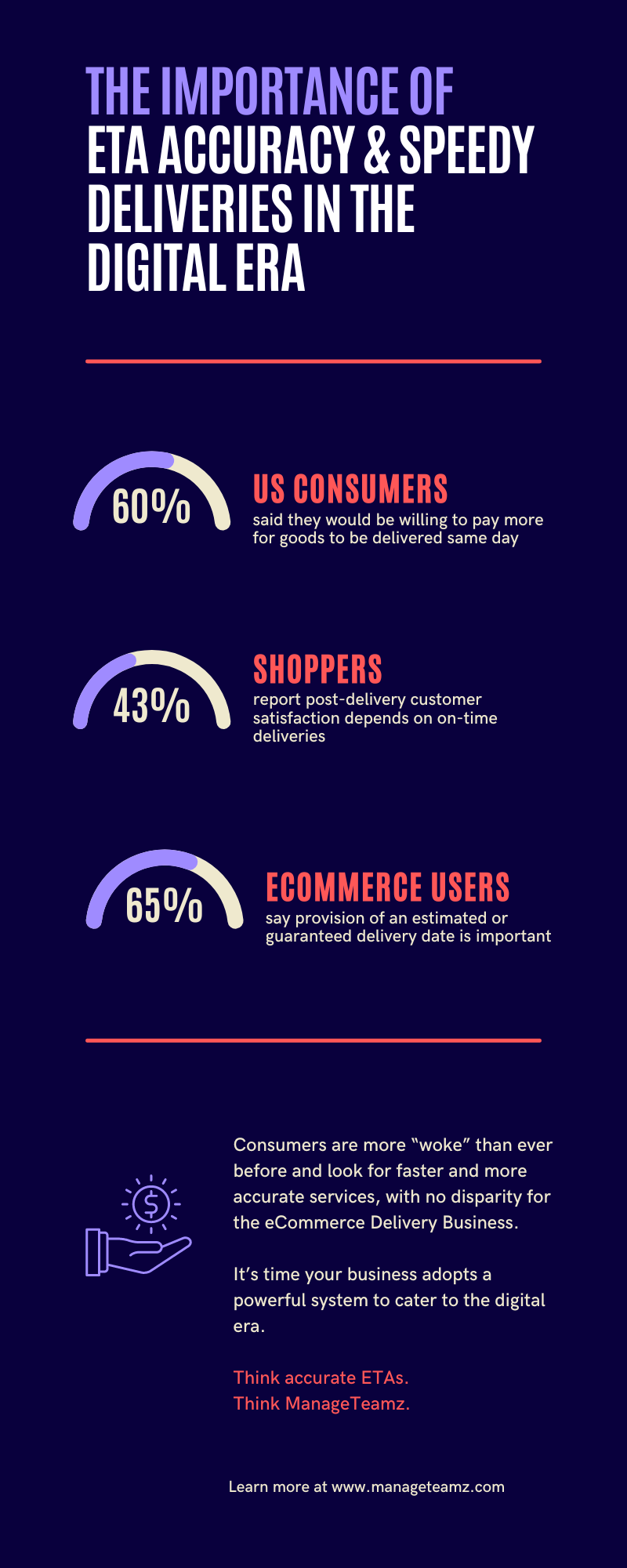Introduction: the problem of ETA accuracy
Estimated Time of Arrival or ETA forecasting accuracy has been a much-debated topic for years now. From the time of antiquated mail deliveries to modern-day shipping schedules, the accuracy of ETA calculations has been crucial for both businesses and consumers. But for all these conversations and advancements, achieving accurate ETAs and on-time deliveries has been an ongoing subject for discussion of the lack of a robust eCommerce delivery management system.
For instance, when the Ever Given run aground in the Suez Canal on 23rd March 2021, approximately USD 500-600 million worth of cargo was stuck for six days, and even further due to subsequent legal and regulatory ramifications of the incident. Not to mention the traffic of cargo this held up in the canal for those six days, highly impacting the ETA of these cargo shipments. Dubbed “The big boat that broke the world,” Ever Given disrupted businesses worldwide and affected everyone down to the last person, waiting for the delivery of some quotidian object.
Scaling down, and in more recent times, Domino’s Pizza found itself in a unique fix. In Bartonville, Texas, the global Pizza brand decided to pave the potholes in the city for 2 reasons – one more overt than the other. Domino’s put it out that they were doing this in order to mitigate the “irreversible damage” that potholes and bumps can do to pizzas on their way to being delivered.
While the more covert issue was that the potholes were also hindering accurate ETA calculations, and affecting the promise of on-time deliveries. This was a huge problem for the brand, albeit one that was much less glamorous than the “irreversible damage” spiel.
Nevertheless, in both instances, factors that were not in control of the original organization(s), were causing blockers in the supply chain and ultimately affecting the ETA accuracy of their last-mile delivery management systems.
But there are certain factors that can be monitored and thus controlled better by organizations – namely the data that they get on delivery times, routes, delivery agent behaviour, etc.
Data & Accuracy – the infinite tango
The accuracy of ETA calculations depends on a lot of tangible and intangible factors. For example, even if you can figure out the exact distance between point A & point B, and the average speed of the courier, you will only get a rudimentary measure of ETA. You may not be able to factor in intangible factors such as traffic, incidents, breaks and courier routes.
But if you are able to set up a delivery management system that factors all this into your calculations, you’d arrive at more accurate ETAs.
Data can be a very powerful tool that provides accuracy for both the courier and the end customer – but this data has to be accurate. Hence, an infinite tango.
Contemporary technologies and operational systems now offer an unprecedented opportunity to get accurate data on these intangible factors. For instance, public map data, which was previously unreliable, offers improved clarity now. Going beyond that, we have the opportunity to leverage geofencing, visual positioning systems and camera positioning standards as well.
Integrating this data can offer improved ETA calculations, as we slowly approach the convergence point of the accuracy of the data and the accuracy of ETAs.
Means to ETA Accuracy
Traditionally, the industry has used 3 major systems for ETA calculations – these systems ranging from rudimentary to advanced have been the go-to so far, and it is necessary to discuss these systems before we look at other technologies and tools.
Math-based ML algorithms
The simplest system focuses on calculating the time to distance by factoring the distance between point A & point B and the average speed of a courier. This system is entirely rule-based and cannot factor in any intangibles, direly affecting ETA accuracy.
Public data – consumer-facing apps
This system utilizes public map data to calculate the ETA of a courier/delivery. The system leverages customer data from apps like Google Maps and simply places GPS tracking of the courier on the customer-facing map. Since these maps also track traffic, weather conditions and other factors, this system can be fairly reliable to track accurate ETAs.
Purpose-built algorithms
Powered by machine learning algorithms, this system builds on the other two systems and is widely accepted as the gold standard in accurate ETA calculations. Last-mile delivery systems usually are not as simple as commuting from point A to point B and can get complicated with multiple drop locations, utility breaks, and other unmapped detainers such as unplanned blockades, security checks, and vehicle failures.
Purpose-built algorithms factor in all of this and offer accurate ETA predictions for customers, helping them have a better understanding of the delivery experience.
Other factors for ETA accuracy
Beyond the 3 systems that have been listed above, there are certainly other factors that define ETA accuracy in last-mile delivery. These factors can be both internal and external including cutting-edge technology that is available now for leverage.
Operational consistencies and inconsistencies
The last mile is a complicated mix of both technology and human factors. Even if we were to deploy the most cutting-edge ETA prediction systems, there is still the risk of human factors that we have to consider. Like any other industry or process, human error is a free radical that has to be taken into account.
Operationally speaking there are several systems to streamline this perspective in the supply chain, but there are always exceptions or inconsistencies.
For instance, in the case of the Ever Given which was stuck in the Suez Canal for 6 days, the crew had a major part to play. Although wind and tide conditions were the primary factors of consideration, human intervention could have helped save millions of dollars and mitigated the damage to global businesses.
Visual Positioning Systems
Visual positioning systems are fairly new and offer opportunities to build on traditional map data. The system leverages users’ phone cameras to plot surroundings and compares the data with Google’s image data to provide more accurate locational data.
Although the technology is still in its nascent stages, industry experts propose that this could be the inevitable future of accurate locational data.
Feeding this data into a last-mile delivery management system can improve ETA accuracy calculations in the future.
What3words
Proprietary technology, the system uses machine learning algorithms to plot 3 different words for particular locations on a map, down to a small square patch of dimensions 3X3 metres. These words, seemingly random are placed in a particular order for each location giving it a very unique digital address, and allowing users to be very accurate with addresses.
Although hypothetical, what3words data can be integrated with the last-mile system through a simple API call, and in combination with traditional map data and purpose-built algorithms, can allow courier operators to calculate ETA accuracy down to the last second.
Tools to ETA Accuracy
Discounting the niche, there are several contemporary technologies that can help delivery management solutions achieve ETA accuracy. Most of these technologies are multi-functional and can be applied in various industries and processes, but aspects of these technologies can, in fact, improve the accuracy of ETA calculations.
Cloud technology is one major enabler of delivery management systems at various levels. The maps themselves and all associated data of tracking and calculation are also based on the Cloud. Most organizations leverage Cloud technologies to drive accurate and real-time delivery tracking results.
Similarly, Machine Learning algorithms can help delivery management solutions compute tangible and intangible data to arrive at clear insights into how ETAs and deliveries can vary the in future. Most delivery management solutions already deploy some level off ML algorithms to compute ETAs but combined with AI, systems can be even more sentient and offer elevated customer experiences.
Why is ETA accuracy imperative right now?
Arriving at accurate ETA predictions has been imperative from the dawn of delivery management systems, but it has never been more crucial than now. Over the last two decades, there have been multiple technological advancements and several global events that have spurred this need for speedier deliveries and accurate ETAs.
For instance, according to a report by Statista, over 83% of the global population owns a smartphone and is fairly technical savvy.
This has made consumers even more demanding and has moved the global average of customer satisfaction and user attention span to new levels.
Another example of a contributing factor to this urgency is the Corona Virus pandemic outbreak of 2020. This singular event pushed more individuals to rely on digital channels of communication and remote services than any other event in history. There was a sudden upsurge in the need for innovative services for even the most basic of requirements, such as everyday groceries and fundamental necessities such as batteries, medicine and sanitary products.
Conclusion: Finding the right innovation partner
All said and done, finding the right innovation/implementation partner who sees the full picture can be a hassle in these times. There are plenty of options that are available in the market, but you need to be selecting a partner who can figure out all the pieces in the puzzle.
A robust delivery management solution would not just allow you to track and manage deliveries, but allow you to go beyond traditional methodologies and create superior delivery experiences for the customer.
ManageTeamz is a pre-built Ecommerce Delivery Management Software with opportunities for customization and optimization based on your business needs. If you are looking to explore how you can improve the accuracy of your ETA calculations, you may want to talk to us.
Like what you’re reading?
Get on a free consultative call with our team of industry experts to explore the possibilities on the subject.








